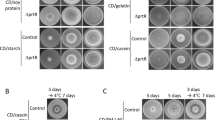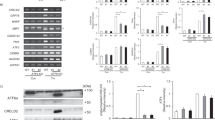Abstract
In response to phosphorus limitation, the fungusNeurospora crassa synthesizes a number of enzymes that function to bring more phosphate into the cell. The NUC-2 protein appears to sense the availability of phosphate and transmits the signal down-stream to the regulatory pathway. Thenuc-2 + gene has been cloned by its ability to restore growth of anuc-2 mutant under restrictive conditions of high pH and low phosphate concentration. We mapped the cloned gene to the right arm of linkage group II, consistent with the chromosomal position of thenuc-2 mutation as determined by classical genetic mapping. Thenuc-2 + open reading frame is interrupted by five introns and codes for a protein of 1066 amino acid residues. Its predicted amino acid sequence has high similarity to that of its homolog inSaccharomyces cerevisiae, PHO81. Both proteins contain six ankyrin repeats, which have been implicated in the cyclin-dependent kinase inhibitory activity of PHO81. The phenotypes of anuc-2 mutant generated by repeat-induced point mutation and of a strain harboring a UV-inducednuc-2 allele are indistinguishable. Both are unable to grow under the restrictive conditions, a phenotype which is to some degree temperature dependent. Thenuc-2 + gene is transcriptionally regulated. A 15-fold increase in the level of thenuc-2 + transcript occurs in response to a decrease in exogenous phosphate concentration.
Similar content being viewed by others
References
Akins RA, Lambowitz AM (1985) General method for cloningNeurospora crassa nuclear genes by complementation of mutants. Mol Cell Biol 5:2272–2278
Aramayo R, Metzenberg, RL (1996) Meiotic transvection in fungi. Cell 86:103–113
Ausubel FM, Brent R, Kingston RE, Moore DD, Seidman JG, Smith JA, Struhl K (1987) Current protocols in molecular biology. Greene Publishing Associates and Wiley-Interscience, New York
Bruchez JJP, Eberle J, Russo VEA (1993) Regulatory sequences in the transcription ofNeurospora crassa genes: CAAT box, TATA box, introns, poly(A) tail formation sequences. Fungal Genet Newslett 40:89–96
Coche T, Prozzi D, Legrain M, Hilger F, Vandenhaute J (1990) Nucleotide sequence of thePHO81 gene involved in the regulation of the repressible acid phosphatase gene inSaccharomyces cerevisiae. Nucleic Acids Res 18:2176
Davis RH, de Serres FJ (1970) Genetic and microbiological techniques forNeurospora crassa. Methods Enzymol 17A:79–143
Devereux JR, Haeberli P, Smithies O (1984) A comprehensive set of sequence analysis programs for the VAX. Nucleic Acids Res 12:387–395
Grotelueschen J, Peleg Y, Glass NL, Metzenberg RL (1994) Cloning and characterization of thepho-2 + gene encoding a repressible alkaline phosphatase inNeurospora crassa. Gene 144:147–148
Kaffman A, Herskowitz I, Tjian R, O'Shea ER (1994) Phosphorylation of transcription factor PHO4 by a cyclin-CDK complex, PHO80-PHO85. Science 263:1153–1156
Kang S (1993) Functional domains of the transcription activator NUC-1 inNeurospora crassa. Gene 130:259–264
Kang S, Metzenberg RL (1990) Molecular analysis ofnuc-1 +, a gene controlling phosphorus acquisition inNeurospora crassa. Mol Cell Biol 10:5839–5848
Kang S, Metzenberg RL (1993) Insertional mutagenesis inNeurospora crassa: cloning and molecular analysis of thepreg + gene controlling the activity of the transcriptional activator NUC-1. Genetics 133:193–202
Kinsey JA, Rambosek JA (1984) Transformation ofNeurospora crassa with the clonedam (glutamate dehydrogenase) gene. Mol Cell Biol 4:117–122
Legerton TL, Yanofsky C (1985) Cloning and characterization of the multifunctionalhis-3 gene ofNeurospora crassa. Gene 39:129–140
Lehman JF, Gleason MK, Ahlgren SK, Metzenberg RL (1973) Regulation of phosphate metabolism inNeurospora crassa. Characterization of regulatory mutants. Genetics 75:61–73
Littlewood BS, Chia W, Metzenberg RL (1975) Genetic control of phosphate-metabolizing enzymes inNeurospora crassa: relationships among regulatory mutations. Genetics 79:419–434
Mann BJ, Akins RA, Lambowitz AM, Metzenberg RL (1988) The structural gene for a phosphorus-repressible phosphate permease inNeurospora crassa can complement a mutation in positive regulatory genenuc-1. Mol Cell Biol 8:1376–1379
Mann BJ, Bowman BJ, Grotelueschen J, Metzenberg RL (1989) Nucleotide sequence ofpho-4 +, endocing a phosphate-repressible phosphate permease ofNeurospora crassa. Gene 83:281–289
Metzenberg RL (1979) Implications of some genetic control mechanisms inNeurospora. Microbiol Rev 43:361–383
Metzenberg RL, Chia W (1979) Genetic control of phosphorus assimilation inNeurospora crassa: dose-dependent dominance and recessiveness in constitutive mutants. Genetics 93:625–643
Metzenberg RL, Grotelueschen J (1995) Restriction polymorphism maps ofNeurospora crassa: update. Fungal Genet Newslett 42:82–90
Metzenberg RL, Stevens JN, Selker EU, Morzycka-Wroblewska E (1984) A method for finding the genetic map position of cloned DNA fragments. Neurospora Newslett 31:35–39
Michaely P, Bennett V (1992) The ANK repeat: a ubiquitous motif involved in macromolecular recognition. Trends Cell Biol 2:127–129
Ogawa N, Noguchi K, Yamashita Y, Yasuhara T, Hayashi N, Yoshida K, Oshima Y (1993) Promoter analysis of thePHO81 gene encoding a 134 kDa protein bearing ankyrin repeats in phosphatase regulon ofSaccharomyces cerevisiae. Mol Gen Genet 238:444–454
Orbach MJ, Sachs MS (1991) The Orbach/Sachs cosmid library ofN. crassa DNA sequences (pMOcosX). Fungal Genet Newslett 38:97
Orbach MJ, Porro EB, Yanofsky C (1986) Cloning and characterization of the gene forβ-tubulin from a benomyl-resistant mutant ofNeurospora crassa and its use as a dominant selectable marker. Mol Cell Biol 6:2452–2461
Oshima Y (1991) Impact of the Douglas-Hawthorne model as a paradigm for elucidating cellular regulatory mechanisms in fungi. Genetics 128:195–201
Peleg Y, Metzenberg RL (1994) Analysis of the DNA-binding and dimerization activities ofNeurospora crassa transcription factor NUC-1. Mol Cell Biol 14:7816–7826
Peter M, Herskowitz I (1994) Joining the complex: cyclin-dependent kinase inhibitory proteins and cell cycle. Cell 79:181–184
Schneider KR, Smith RL, O'Shea EK (1994) Phosphate-regulated inactivation of the kinase PHO80-PHO85 by the CDK inhibitor PHO81. Science 226:122–126
Selker EU, Garrett PW (1988) DNA sequence duplications trigger gene inactivation inNeurospora crassa. Proc Natl Acad Sci USA 85:6870–6874
Selker EU, Cambareri EB, Jensen BC, Haack KR (1987) Rearrangements of duplicated DNA in specialized cells ofNeurospora. Cell 51:741–752
Timberlake WE (1986) Isolation of stage- and cell-specific genes from fungi. In: Bailey J (ed) Biology and molecular biology of plant-pathogen interactions. Springer-Verlag, Berlin, Heidelberg, New York pp 343–357
Toh-e A, Ishikawa T (1971) Genetic control of synthesis of repressible phosphatases inNeurospora crassa. Genetics 69:339–351
Toh-e A, Shimauchi T (1986) Cloning and sequencing of thePHO80 gene andCEN15 ofSaccharomyces cerevisiae. Yeast 2:129–139
Toh-e A, Tanaka K, Uesono Y, Wickner RB (1988)PHO85, a negative regulator of the PHO system, is a homolog of the protein kinase gene,CDC28, ofSaccharomyces cerevisiae. Mol Gen Genet 214:162–164
Uesono Y, Tanaka K, Toh-e A (1987) Negative regulators of the PHO system inSaccharomyces cerevisiae: isolation and structural characterization ofPHO85. Nucleic Acids Res 15:10299–10309
Versaw WK (1995) A phosphate-repressible, high-affinity phosphate permease is encoded by thepho-5 + gene ofNeurospora crassa. Gene 153:135–139
Vogel K, Hinnen A (1990) The phosphatase system. Mol Microbiol 4:2013–2017
Vogel K, Hörz W, Hinnen A (1989) The two positively acting regulatory proteins PHO2 and PHO4 physically interact with PHO5 upstream regulatory activation regions. Mol Cell Biol 9:2050–2057
Vollmer SJ, Yanofsky C (1986) Efficient cloning of genes ofNeurospora crassa. Proc Natl Acad Sci USA 83:4869–4873
Westergaard M, Mitchell HK (1947) Neurospora cloning of genes ofNeurospora crassa. Proc Natl Acad Sci USA 83:4869–4873
Westergaard M, Mitchell HK (1947) Neurospora V. A synthetic medium favoring sexual reproduction. Am J Bot 34:573–577
Yoshida K, Ogawa N, Oshima Y (1989) Function of thePHO regulatory genes for repressible acid phosphatase synthesis inSaccharomyces cerevisiae. Mol Gen Genet 217:40–46
Author information
Authors and Affiliations
Additional information
Communicated by C. van den Hondel
Rights and permissions
About this article
Cite this article
Peleg, Y., Aramayo, R., Kang, S. et al. NUC-2, a component of the phosphate-regulated signal transduction pathway inNeurospora crassa, is an ankyrin repeat protein. Molec. Gen. Genet. 252, 709–716 (1996). https://doi.org/10.1007/BF02173977
Received:
Accepted:
Issue Date:
DOI: https://doi.org/10.1007/BF02173977




